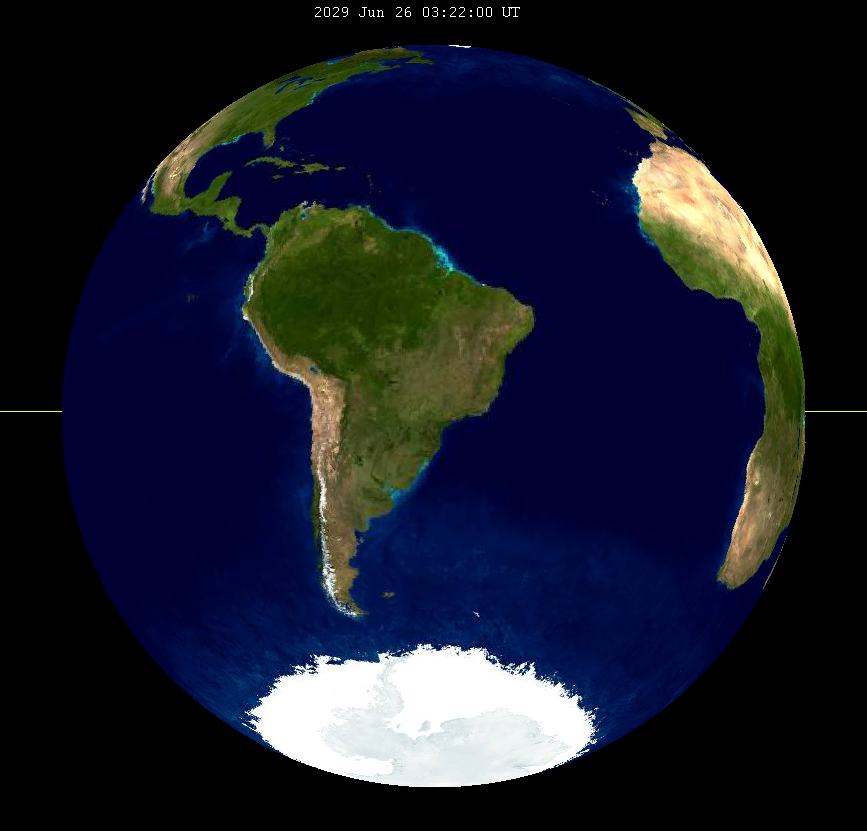June 2029 Lunar Eclipse on:
[Wikipedia]
[Google]
[Amazon]
A total lunar eclipse will take place on Tuesday, June 26, 2029. A dramatic total eclipse lasting 1 hour and 41 minutes 53 seconds will plunge the

full Moon
The full moon is the lunar phase when the Moon appears fully illuminated from Earth's perspective. This occurs when Earth is located between the Sun and the Moon (when the ecliptic longitudes of the Sun and Moon differ by 180°). This means ...
into deep darkness, as it passes right through the centre of the Earth's umbral shadow. While the visual effect of a total eclipse is variable, the Moon
The Moon is Earth's only natural satellite. It is the fifth largest satellite in the Solar System and the largest and most massive relative to its parent planet, with a diameter about one-quarter that of Earth (comparable to the width of ...
may be stained a deep orange or red color at maximum eclipse. This will be a great spectacle for everyone who sees it from most of the Americas and western Europe and Africa. The partial eclipse will last for 3 hours and 39 minutes 32 seconds in total.
The moon will pass through the center of the Earth's shadow. Totality will last 101 minutes 53 seconds, the maximum duration for Saros series 130.
With an umbral eclipse magnitude of 1.84362, this is the largest lunar eclipse of the 21st century
The 21st (twenty-first) century is the current century in the ''Anno Domini'' era or Common Era, under the Gregorian calendar. It began on 1 January 2001 ( MMI) and will end on 31 December 2100 ( MMC).
Marking the beginning of the 21st centur ...
. Gamma has a value of only 0.01240. Due to the Moon's relatively large size as seen from Earth
Earth is the third planet from the Sun and the only astronomical object known to harbor life. While large volumes of water can be found throughout the Solar System, only Earth sustains liquid surface water. About 71% of Earth's surfa ...
and greater speed in its elliptical orbit, totality will not last over 106 minutes. This is the darkest and greatest total lunar eclipse in the 21st century.
Visibility
It will be completely visible over South America, seen rising over North America, and setting over Africa and Europe.
Related lunar eclipses
Lunar year series
Metonic series
Saros series
Inex series
Tritos
* Preceded: Lunar eclipse of July 27, 2018 * Followed: Lunar eclipse of May 26, 2040Tzolkinex
* Preceded: Lunar eclipse of May 16, 2022 * Followed: Lunar eclipse of August 7, 2036Half-Saros cycle
A lunar eclipse will be preceded and followed by solar eclipses by 9 years and 5.5 days (a half saros).Mathematical Astronomy Morsels, Jean Meeus, p.110, Chapter 18, ''The half-saros'' This lunar eclipse is related to two annular solar eclipses ofSolar Saros 137
Saros cycle
The saros () is a period of exactly 223 synodic months, approximately 6585.3211 days, or 18 years, 10, 11, or 12 days (depending on the number of leap years), and 8 hours, that can be used to predict eclipses of the Sun and Moon. ...
.
See also
*List of lunar eclipses
There are several lists of lunar eclipses
On the Moon, by the Earth
; Type
* List of central lunar eclipses
* Total penumbral lunar eclipse
; Classification
* List of saros series for lunar eclipses
* Tetrad (astronomy) contains lists of tetrads ...
and List of 21st-century lunar eclipses
There will be 230 lunar eclipses in the 21st century (2001–2100): 87 penumbral, 58 partial and 85 total.
Eclipses are listed in sets by lunar years, repeating every 12 months for each node. Ascending node eclipses are given a red background hig ...
Notes
External links
* 2029-06 2029-06 2029-06 2029 in science {{lunar-eclipse-stub